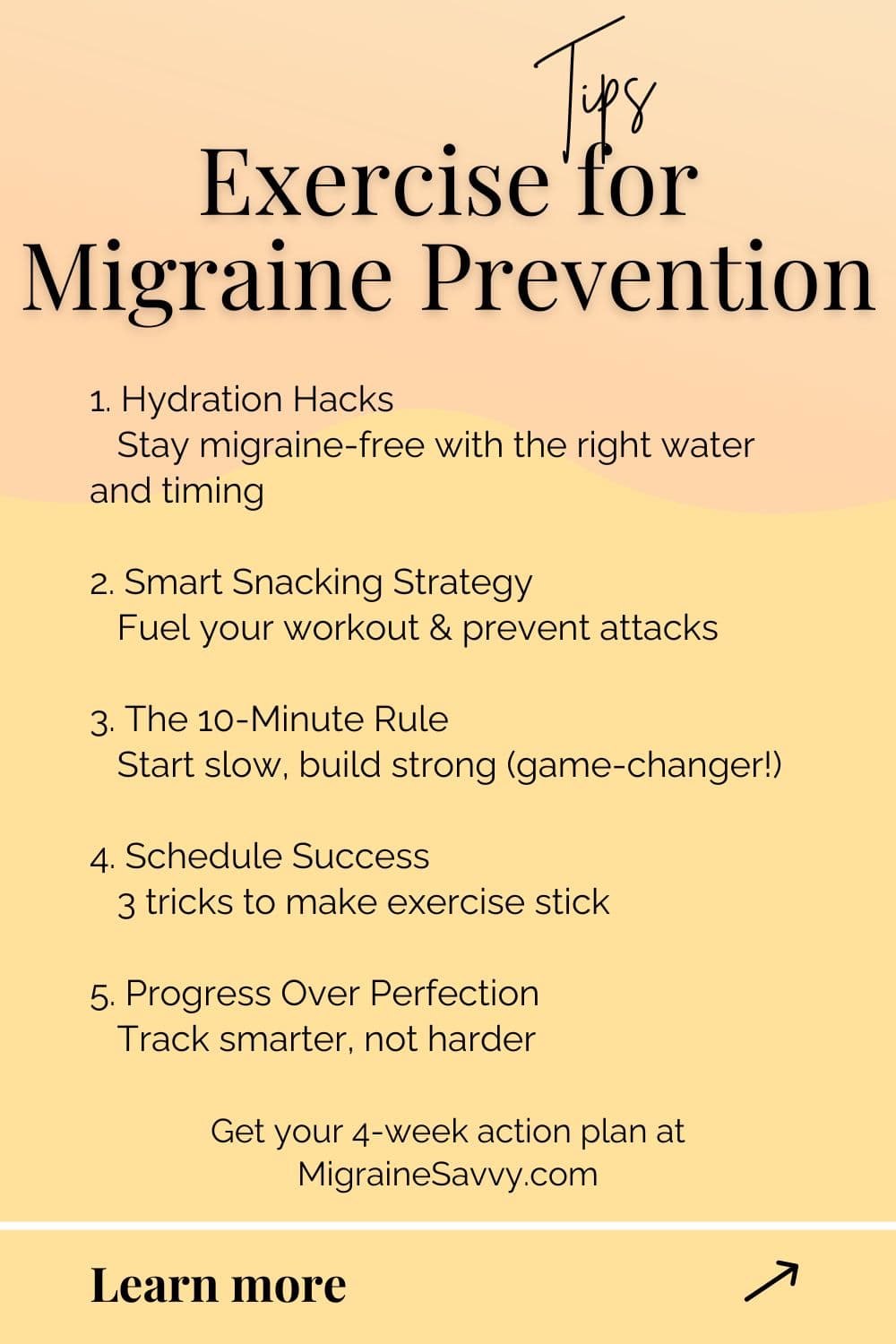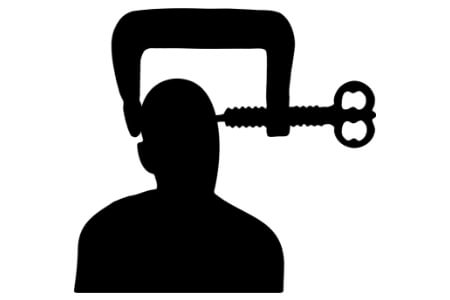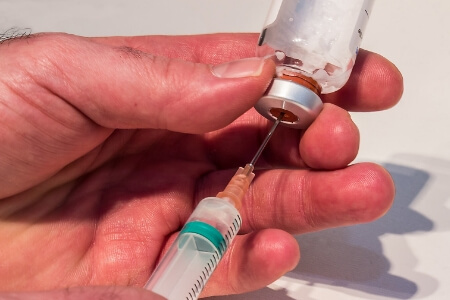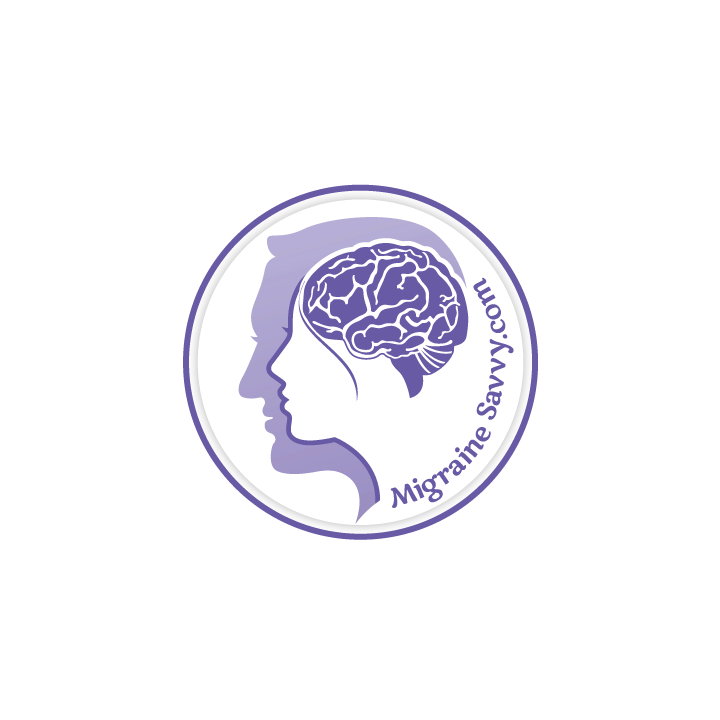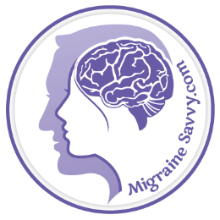- Home
- Prevention Tips
- Exercise for Migraine Prevention
COMPLETE MAGNESIUM SUPPORT
My Top Choice - Magnesium Breakthrough - The ONLY supplement with all 7 essential magnesium types in one formula. Most only have 1-2 types, leaving you deficient.
Exercise for Migraine Prevention: 5 Tips to Make It Easier
Do you exercise for migraine prevention? If not, here are 5 tips to help make it easier and a 4-week action plan you can start today.
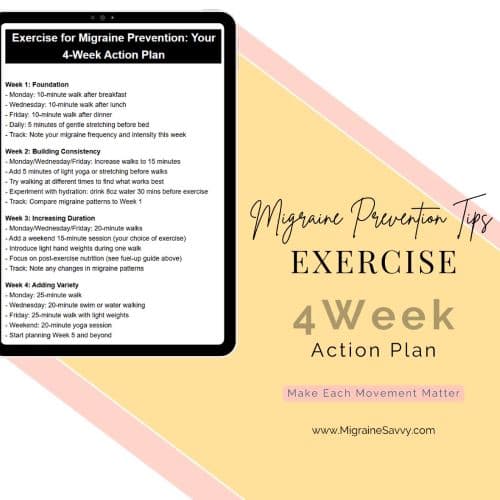
Let's get straight to the point - exercise can help prevent migraines. Studies show that regular physical activity can reduce how often you get migraine attacks and how bad they are when they hit. Why? Your body releases endorphins (natural painkillers) when you exercise, which can help raise your pain threshold and reduce the frequency of attacks.
Will Exercise Prevent Your Next Attack?
The Science Behind Exercise and Migraine Attacks
Recent research is pretty convincing:
- A landmark study found that exercising for 40 minutes, three times a week, worked as well as relaxation techniques or medication (specifically topiramate) for preventing migraine attacks [1]
- Scientists in 2018 identified a crucial cycle: migraines make it hard to exercise, but not exercising can make migraines worse. Breaking this cycle is key to improvement [2]
- Regular moderate exercise has been shown to reduce migraine frequency by up to 40% in some patients over a 3-month period [2]
The evidence informs the existence of a vicious cycle, in which migraine becomes a major impediment for regular exercise performance and, in turn, a lower level of physical exercise would then contribute to worsen severity, frequency and duration of migraine attacks, thus further limiting the willingness of migraineurs to exercise. Therefore, regular engagement in moderate-intensity aerobic exercise (i.e. ≥40 min, 3 times per week) may be regarded as a reasonable preventive measure.
~ Lippi, Mattiuzzi, et al. [2]
My #1 Choice in Magnesium Supplements
Common Questions About Exercise for Migraine Prevention
Just click on the little arrow for the answer.
Can you exercise with a migraine?
Can you exercise with a migraine?
Answer: Generally, it's not recommended to exercise during a migraine attack. Most people need to rest in a quiet, dark place. However, some people do find relief if they do exercise. Experiment to see if it works for you. Very gentle movement like slow walking or light stretching might help once the pain phase has passed. Always listen to your body and stop if pain increases.
Can exercise cause migraine headaches?
Can exercise cause migraine headaches?
Answer: Yes, exercise can trigger migraine attacks in some people, especially with sudden, intense activity or improper form. However, regular, moderate exercise often helps prevent migraines long-term. Starting slowly and staying well-hydrated can help reduce exercise-triggered headaches. We'll cover all of that, so keep reading.
Should I just do neck exercises for migraine prevention?
Should I just do neck exercises for migraine prevention?
Answer: Yes and no! Targeted neck exercises for migraine prevention can be very effective. They help reduce tension in the cervical spine, which is often linked to headaches and migraines. And you need to strengthen your neck if you want Botox injections!! However, a complete migraine prevention strategy should combine neck exercises with other types of physical activity for best results.
Want to learn more? Download the free tool kit with a specialized neck exercise for migraine prevention. These gentle movements can help reduce tension and prevent attacks. Join the mailing list to get instant access.

5 Practical Tips to Make Exercise Work for You
Here are some tips to help you plan your exercise for migraine prevention strategy and maintain it:
#1. Stay Hydrated
Drink Water (But Do It Right)
Dehydration is a common migraine trigger, and exercise can dehydrate you faster than you might realize.
- Have 16-20 oz of water 2-3 hours before exercise
- Drink 8 oz every 15-20 minutes during your workout
- After exercising, drink enough to replace what you lost through sweat*
Quick check: If your mouth is dry or you're thirsty, you're already dehydrated. Watch your urine color - pale yellow is ideal. Brown tinge signals dehydration.
Pro tip: Add a pinch of salt to your water or try coconut water for better hydration. Sports drinks can work but watch the sugar content. If you sweat heavily, consider electrolyte powder dissolved in water.
*The American Migraine Foundation says to "make sure that your mouth is not dry and that you sweat. If you are thirsty, that is a sign that you have a substantial fluid deficit and may trigger a migraine. If you do not sweat when you are exercising at a moderate to vigorous level, it is a sign of dehydration." [1]
>> Here's my best dehydration recipe
#2. Eat Beforehand to Keep Blood Sugar Balanced
Smart Snacking Strategy to Fuel Up
What you eat before and after exercise can make or break your workout and migraine prevention efforts.
Exercise will cause your blood sugar level to decrease, and it’s really important to have a good source of energy.
So - protein rich foods are best. A protein bar or nuts, are good snacks to have prior to exercise. If you find yourself getting cramps when you've eaten too soon prior to exercise, you’ll need to schedule your snacks / meals and exercise more carefully.
Here are some best practices...
Before exercise (90 minutes prior) aim for easily digestible proteins, some fat and complex carbs. I prefer half a loaded smoothie with all my goodies in it. Protein powder, blueberries, coconut water, supplements, and nut paste (YUM!).
Good options:
- Plain coconut yogurt with berries and seeds or nuts
- Gluten free seeded toast with peanut butter (any nut butter)
- Apple slices with cheese or nut paste, cinnamon
- Trail mix with nuts and dried fruit
- Half an egg salad sandwich on your favorite gluten free bread
Post-workout (within 30 minutes) focus on replenishing nutrients. Try any of the options above or have the other half of your protein smoothie.
Be sure to test half a cup of blueberries versus a full cup, and half a banana instead of a whole banana - as these full doses may trigger an attack when the half does not.
>> Here's my food and supplement testing journal
#3. Start Slow, End Slow
Sudden changes in physical activity can trigger a migraine attack, so easing in and out is crucial.
Make sure you warm-up with some stretches or slow-paced walking. Don’t jump straight into sudden, vigorous exercise. Slow gentle versions of what you are about to do is best.
So, if speed walking is your exercise of choice, walk for five minutes at a slow pace for about two and a half to three miles per hour before speeding up your pace. Or if you’re doing weights, make sure to lift lighter weights before doing the more intense resistance training.
Start slow and light and build up. And then end slow and cool down.
There's recently been some debate around stretching... and pandiculation is now recommended. I prefer this for sure... but it's up to you to experiment with. I recommend checking out pandiculation. It's awesome.
>> I did this course, no affiliate, I just loved it
Warm-up essentials (10-15 minutes):
- Start with dynamic movements: arm circles, leg swings, gentle twists
- Progress to activity-specific moves at a lower intensity
- Example for runners: Start with a brisk walk, move to a slow jog, then increase speed
Try pandiculation:
- This is how animals naturally stretch - think of a cat or dog waking up
- Gently engage your muscles, hold briefly, then slowly release
- More effective than traditional static stretching for preparing your body
Cool-down matters too:
- Gradually reduce intensity over 5-10 minutes
- Include gentle stretching when your muscles are warm
P.S. Try this full spectrum magnesium... I LOVE it.
My #1 Choice - Magnesium Breakthrough by BiOptimizers - combines 7 types of magnesium in a humic/fulvic monoatomic blend to optimize absorption. This is by far the best product I have found so far in terms of results.
#4. Schedule It In
Make Time (and Stick to It)
Consistency is key for both exercise benefits and migraine prevention.
It can be really hard to schedule in exercise time just for yourself. But if you get migraine headaches, it might help to look at this as part of your migraine prevention strategy.
"A regular schedule is always beneficial in headache and migraine management." [1]
Here are some tips for success!!
Practical scheduling tips:
- Start with 3 sessions per week, 30-40 minutes each OR...
- Use movement snacking - do 10 minutes three times a day; or 15 minutes twice a day
- Pick the same days and times each week to build this habit
- Put it in your calendar with a reminder on your phone 1 hour before
- Lay out your exercise clothes the night before
Parent-specific strategies:
- Look for gyms with childcare (many YMCAs have this)
- Try home workout videos during nap time
- Make exercise a family activity - family walks or bike rides
- Trade childcare with another parent for workout time
Learning to say no:
- Prepare a simple response for conflicts: "Sorry, I have a prior commitment"
- Remember: your health is a priority, not an indulgence
#5. Track Your Progress
Recording your exercise and migraine patterns helps you identify what works and motivates you to continue.
What to track:
- Type and duration of exercise
- Intensity level (1-10 scale)
- How you felt before, during, and after
- Any migraine symptoms that day or the next
- Sleep quality the night before and after
Tracking methods:
- Simple notepad and pen
- Smartphone apps like Migraine Buddy
- Fitness tracker data combined with migraine notes
>> Get free tracking tools by signing up for the newsletter
>> Get my symptoms tracker here
>> See my bookstore for other goodies
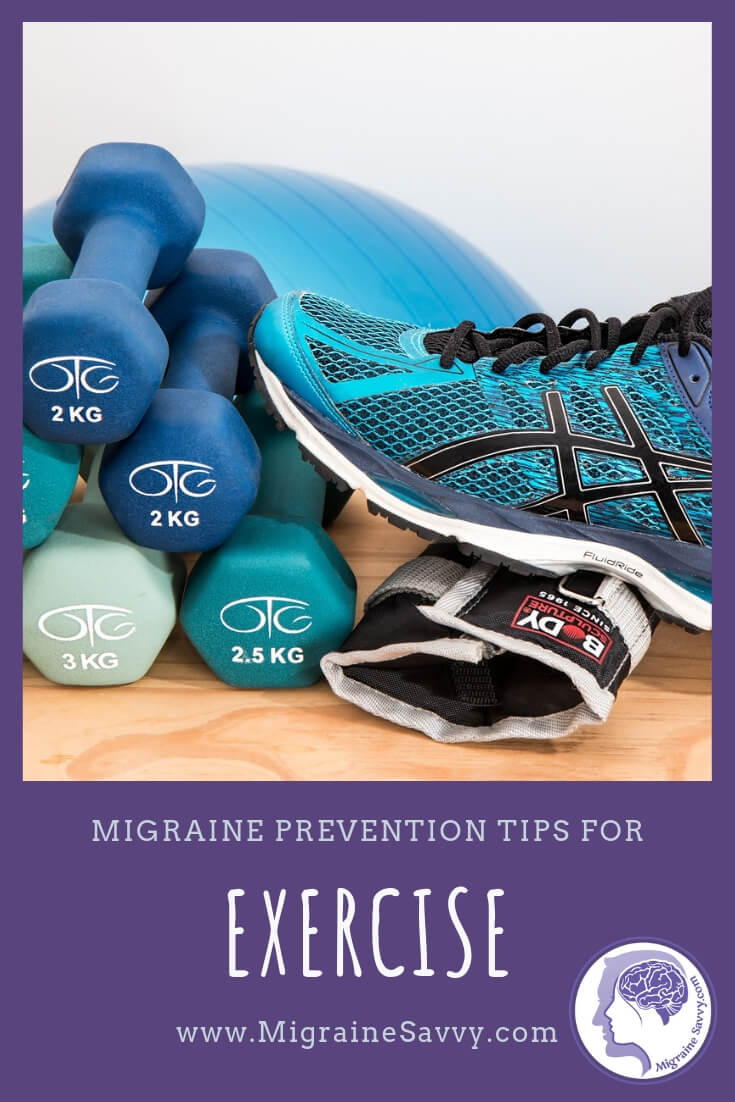 Exercise for Migraine Prevention Tips and Ideas to Help You Succeed.
Exercise for Migraine Prevention Tips and Ideas to Help You Succeed.Exercise Options That Actually Work
To have a well-rounded routine it's best to cover these four types of exercise: endurance, strength, balance, and flexibility. These don't need to be done every day, but using a variety will help keep your body healthy and fit, and you interested and motivated.
Many types of exercises, like yoga for example, will improve balance, strength and flexibility.
Cardio-respiratory endurance:
- brisk walking, hiking, jogging, running, cycling (mountain biking), swimming, jumping rope, rowing, tennis, dancing, surfing, or cross-country skiing. Any sports like basketball or racquetball. Step aerobics or climbing stairs are good too.
Increase muscular strength:
- lift weights, resistance bands, free weights like barbells and dumbbells or weight machines. Heavy gardening like digging and shoveling. Climbing stairs, cycling, dancing, push-ups, sit-ups, pull-ups, chin-ups, squats.
Improve your endurance:
- aerobic exercises like walking, jogging, swimming and biking. High intensity lifting, calisthenics (conditioning exercises), weight training, any activities that increase breathing and heart rate.
Increase flexibility and balance:
- stretching exercises like yoga or Pilates. Stand on one leg, balance on a wobble board, Tai Chi.
If you choose activities that you enjoy, it will be easier to maintain a regular routine.
Beginner-Friendly Choices
1. Walking
- Start with 10 minutes, 3 times per day
- Build up to 30 continuous minutes
- Add hills or intervals once comfortable
2. Swimming
- Excellent for heat-sensitive individuals
- Start with 10 minutes of gentle swimming
- Focus on steady, rhythmic breathing
- Try water walking if swimming is too intense
3. Yoga
- Look for "gentle" or "beginner" classes
- Inform the instructor about your migraines
- Avoid poses that put your head below your heart initially
- Focus on breathing and mindful movement
When You're Ready for More
Progress to these options as your fitness improves:
- Cycling (stationary bikes are great for beginners)
- Light weight training (start with bodyweight exercises)
- Dance classes (low-impact options like barre or slow flow)
- Elliptical machines (less impact than running)
Warning Signs to Watch For
Stop exercising and seek professional advice if you experience:
- Sudden, severe head pain during exercise
- Dizziness or vertigo
- Unusual fatigue that doesn't improve with rest
- Visual disturbances or aura symptoms
- Neck pain or stiffness
If exercise consistently triggers a migraine attack, talk to your doctor about:
- A recommended medication before exercise
- Adjusting other medications you are on
- Checking for underlying conditions
Remember: The best exercise for migraine prevention is one that you can stick to consistently. Start small, be patient with yourself, and gradually build up your routine. Your future self (with fewer migraines) will thank you.
Exercise for Migraine Prevention: Your 4-Week Action Plan
Week 1: Foundation
- Monday: 10-minute walk after breakfast
- Wednesday: 10-minute walk after lunch
- Friday: 10-minute walk after dinner
- Daily: 5 minutes of gentle stretching before bed
- Track: Note your migraine frequency and intensity this week
Week 2: Building Consistency
- Monday/Wednesday/Friday: Increase walks to 15 minutes
- Add 5 minutes of light yoga or stretching before walks
- Try walking at different times to find what works best
- Experiment with hydration: drink 8oz water 30 mins before exercise
- Track: Compare migraine patterns to week 1
Week 3: Increasing Duration
- Monday/Wednesday/Friday: 20-minute walks
- Add a weekend 15-minute session (your choice of exercise)
- Introduce light hand weights during one walk
- Focus on post-exercise nutrition (see fuel-up guide above)
- Track: Note any changes in migraine patterns
Week 4: Adding Variety
- Monday: 25-minute walk
- Wednesday: 20-minute swim or water walking
- Friday: 25-minute walk with light weights
- Weekend: 20-minute yoga session
- Start planning week 5 and beyond
Tips for Success
- Get your workout gear ready the night before
- Set phone reminders for exercise times
- Have a backup plan for bad weather
- Record how you feel after each session
Monthly Progress Check
After completing the 4-week plan, assess:
- Changes in migraine frequency and intensity
- Overall energy levels
- Sleep quality
- Stress levels
Next Steps
If you're doing well, you can gradually increase duration by 5 minutes each week until you reach your desired time to exercise.
If you're struggling, stick to week 2 or 3 level for another week or so. Progress as you feel stronger. Or seek out professional guidance from an exercise physiologist for more help and motivation.
If you are experiencing more migraine attacks - consult your doctor about adjusting the plan.
I hope this all helps you exercise for migraine prevention successfully!
Holly x
WANT MORE TIPS? Subscribe to my newsletter and follow along on Facebook and Pinterest for all of the latest updates.
MIGRAINE PREVENTION Related Articles
How to be more MIGRAINE SAVVY right now...
Exercise for Migraine Prevention Page Sources:
1. The American Migraine Foundation (2015) Effects of Exercise on Headaches and Migraines. Available [online] at: https://americanmigrainefoundation.org/resource-library/effects-of-exercise-on-headaches-and-migraines/
2. Lippi, G., Mattiuzzi, C., & Sanchis-Gomar, F. (2018). Physical exercise and migraine: for or against?. Annals of translational medicine, 6(10), 181. Available [online] at: https://www.ncbi.nlm.nih.gov/pmc/articles/PMC5994516/ Accessed Mar. 5, 2019.
Updated Oct. 5, 2024

